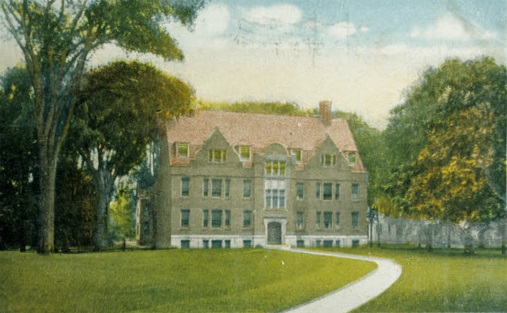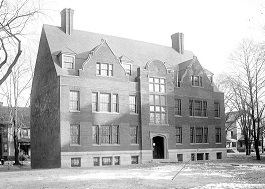
| Prince Street Campus | Kendrick Hall |
 |
| Kendrick Hall, from old postcard |
| Picture of Kendrick Hall |
 |
Kendrick
Hall, named after Professor of Greek Asahel
C. Kendrick, was the first dormitory for the University of
Rochester and opened in January 1913 to house men on the Prince Street
Campus. It was converted to a cooperative dormitory for women
when the College for Men moved to River Campus in 1930 and was sold in
1955 for use as an apartment building. It was demolished around
1966 and replaced with a new office building.
References
1895 "At A Ripe Old
Age," Democrat and Chronicle, October 22, 1895, Page 5.
Dr. A. C. Kendrick Died in This City Last Evening
1912 "To
Be Focus of Life on Campus," Democrat and Chronicle, May 28,
1912, Page 14.
Social Room for Men in University Dormitory. Named for A. C.
Kendrick.
The scale of rentals that was decided upon by the trustees at their last
meeting was as follows. For suites of rooms on the first and second
floor facing thecampus, $90 a year a student, or about $2.25 a week.
For suites of rooms facing College avenue, on the fist and second floors,
$80 a year a student, or about $2 a week. For suites on the third
floor facing the campus, $75 a year and for suites on the College Avenue
side of the third floor, $60 a year a student.
1913 Annual
Catalogue of the University of Rochester
Pages 14-15: Dormitory for Men
1913 An American Scholar: A Tribute to Asahel Clark Kendrick, 1809-1895, by Florence Hopkins Kendrick Cooper | also here |
1927 "Lunch
Room at University, Run by Loss, Will be Continued if Students Use It,"
Democrat and Chronicle, Mar 13, 1927, Page 49.
In Kendrick Hall.
1927 Rochester,
the making of a university, by Jesse Leonard Rosenberger, with
an introduction by President Rush Rhees.
Page 293: Following the completion of the Carnegie Building in 1911,
the years of 1912 to 1914, inclusive, were years of almost continuous
activity in building. First of all, a dormitory for men, which President
Rhees had for years wanted, was erected, and was opened for use in
January, 1913. It was called "Kendrick Hall," in memory of Asahel C.
Kendrick, who was professor of the Greek language and literature from 1850
until the time of his death in 1895, although he ceased to give
instruction in 1888.
1931 "Score of University Women Start Housekeeping in Man-Deserted Kendrick Hall to Cut Expenses," Democrat and Chronicle, October 11, 1931, Page II-1.
1932 "Living
Costs? They're Least of 20 U. of R. Girls' Worries, for they Amount to
Only $2.62 a Week," Democrat and Chronicle, June 5, 1932,
Page 15.
Kendrick Hall Co-operative Dormitory
1955 "Kendrick
Hall Sold by UR for Use as Apartment House," Democrat and
Chronicle, August 19, 1955, Page 21.
Kendrick Hall dormitory at 65 College Ave. yesterday afternoon became the
first building on the former Prince Street Campus of the University of
Rochester College for Women to pass from ownership of the University.
Also sold the Bragdon House at 35 Strathallan Pk., corner of University
Avenue, and Allton House, 493 University Ave.
1977 History
of the University of Rochester, by Arthur J. May (on-line
version with footnotes)
Chapter 15, Widening Horizons
Before the end of the first phase of the Rhees era, an alumnus was heard
to remark that the campus would soon be so crowded with buildings that it
would be impossible to install a hitching post. That wry observation was
prompted by news (1907) that Grant Hugh Browne, 1885, a New York
financier, wished to erect a dormitory for men. Unlike President Anderson,
Rhees believed a college residence hall would be an asset, a magnet to
draw students from out of the city, and the trustees endorsed that
reasoning. Blueprints were prepared, but Browne, alas, went bankrupt, and
the project was placed on the shelf until 1911. "Prexy" then proposed that
dining facilities should be provided along with living quarters. In final
form, the plans called for a residence center consisting of three
sections, which would not only be cheaper than three individual
structures, but would conserve space and look more attractive. Each
section would rise to three stories with four suites on each floor,
capable of caring for twenty-four men in all. Each suite would have a
study with a fireplace, and two sleeping rooms; bathrooms on each floor
would be equipped with showers.
By trustee decision the middle section would be built first, with two
wings to be added when the need arose. It would be constructed of red
brick and trimmed with red sandstone. Part of the first level was
eventually set aside as a congenial place for student gatherings in an
informal atmosphere, and after World War I a lunchroom was laid out in the
basement. In keeping with undergraduate suggestions, a site between
Anderson and Sibley Halls was chosen, in the heart of the campus, where
the residence hall would help to promote activities, it was urged, that
rounded out the college experience.
Funds having been furnished largely by alumni and trustees, work started
in 1912 and in January , 1913, a few students moved into the finished
portion of the dormitory. It was first thought of giving the name of Mixer
to the section but eventually the honor went to Asahel C. Kendrick,
professor of Greek, in the original Rochester faculty, in the hope that
occupants would be reminded daily that the aim of the college was to
educate cultured citizens who would cherish opportunities for reading and
acquire a love of poetry and all forms of beauty, as Kendrick himself had
done. Student sentiment favored, instead of simply Kendrick, the
affectionate title of Kai Gar Hall. As matters turned out, the first
section of the residence hall was the only part ever completed.
© 2021 Morris A. Pierce